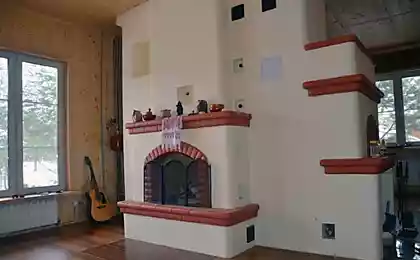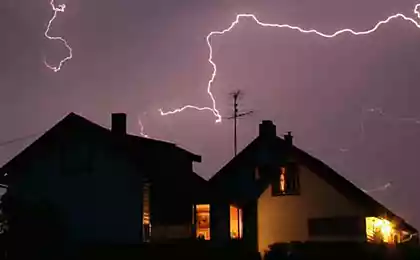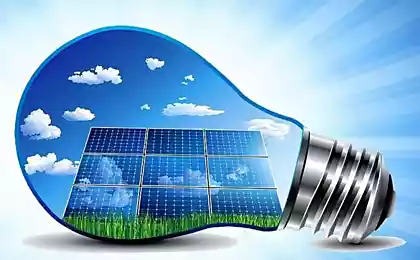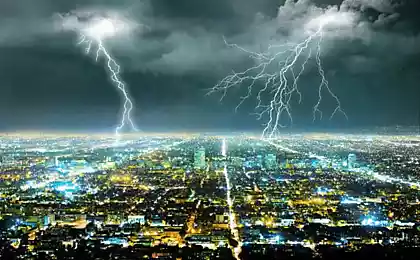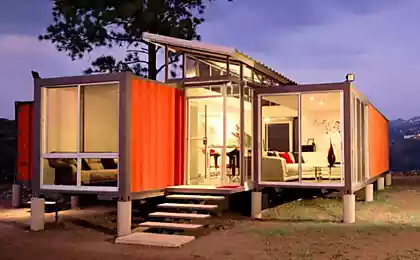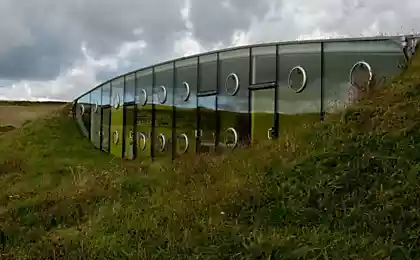665
Lightning protection for a country house: what, why and how
All are familiar with the storm and its most dangerous manifestation of lightning. And although in the middle part of Russia thunderstorms usually happen only in the warm season, the risk of suffering from lightning does not become less.

After all, this is a giant electrical discharge of incredible power, whose voltage can reach several million Volts.
Whether at the cottage the lightning rod?A lightning strike to a building can lead to:
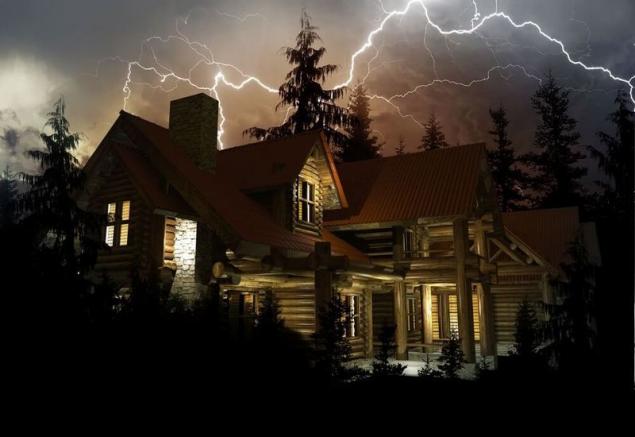
That's why every self-respecting vacationer should take care of the security of their property and their families. But forewarned is forearmed.
The history of lightning protectionHistory erases from the memory the information about the origin of things, have become for us everyday, and not always reliably possible to know of the pioneer, without which we already can not imagine my life. According to official figures, the lightning rod was invented in 1752, the American Benjamin Franklin, whose stern portrait from 1928 looks at us with hundred dollar bills (or rather, those of us who have them). But with the withdrawal of the lightning worked well before Franklin. The mariners of Ancient Greece, for example, set the sword at the top of the mast, was tied to a wet rope and lowered the end of the rope into the water. Subsequently, it was replaced with a metal chain.
Risky experiment has Long been known that lightning usually fall within the objects rising above the earth's surface — trees, poles, masts.

And experiments with atmospheric electricity was carried out in many countries by different scientists. Franklin astutely pointed out that if the source category (electric car) connect a metal rod with the earth, the discharge from the machine, without sparks, and cod runs into the ground. And if the lightning was the same electric spark, why with his sharpened metal pole to discharge the cloud and not take dangerous charges in the ground? The research of Franklin consisted of the following: lightning falls into a special lightning rod which is installed higher than the level of the protected structure, then through the electrodes of the charge goes to the ground, and from there goes into the ground
Franklin decided to catch the lightning a kite at the end of which he tied a sharp nail. When the storm began, he launched the kite. In fact, lightning struck, and the wet rope held the electrical charge on its own from the top end to the bottom. By some incredible Fluke, the experimenter was not injured. From this experience he concluded that occurs during a thunderstorm the electric charges can be caught and taken to a safe place. So there was a device that in the Russian language for some reason called a lightning rod, though "assigns" it did not thunder, and lightning.
Options lightning protection Lightning rod is a metal pole, which is placed above a building and connected by wire with the ground. And the whole giant electrical discharge of lightning, causing harm to no one, goes into the ground.
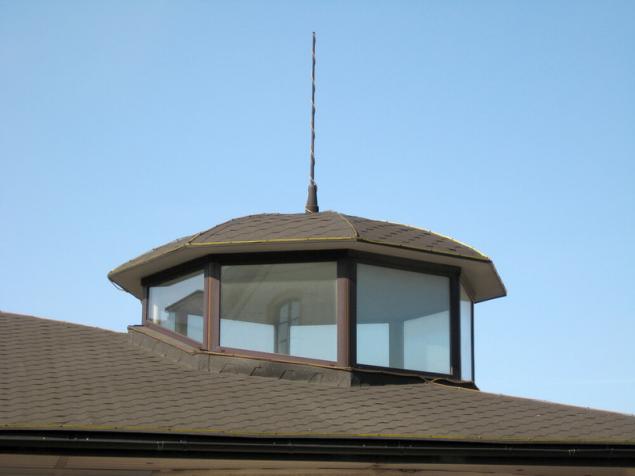
According to the principle of lightning protection can be active or passive.
Active lightning protectionActive lightning protection, introduced in the mid 1980-ies, is the lightning, which does not take developing on top of a cloud discharge (streamer), but on the contrary, ionizes the air (which facilitates the passage of lightning) and creates a rapid discharge side of the zipper (the return streamer). If lightning will occur over the protected area, it is sure to be caught by lightning, and its discharge is taken to earth through the earthing system.
Devices may be specialized electronic circuits and switches, designed to trigger upon reaching a certain electric field intensity, and even small amounts of radioactive materials. Active protection system is much more expensive and complicated passive.
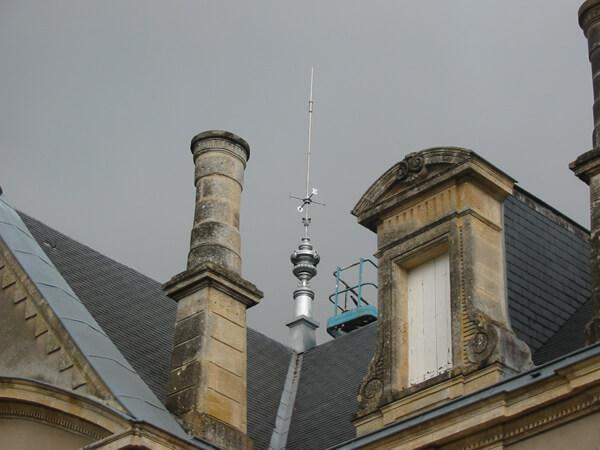
Advocates of active lightning protection claim that their lightning response generate early streamers of greater length compared to passive. This allows you to use less lines, and you can arrange them below. But despite such statements, the unconditional recognition of specialists active lightning rods are not found.
Passive lightning protectionthe Principle of operation of devices of passive lightning protection is quite simple and is based on the property of lightning to hit the high and grounded structures with good electrical conductivity. He is to intercept lightning, bound to the object and securing it in the ground, where it will not be able to hurt anyone, and in mitigating its impact for internal communications in the home.
Passive lightning may have a rod or cable design. Rod the lightning rod, towering above the protected object, — a classic lightning protection. In this case, lightning is caught in a protected area at the time of discharge.
Due to the elevation of the protected object and the special material from which it is made, the lightning rod takes the hit and passes it on through the collector to ground.
Another option passive lightning protection — cable system when the "interceptor" is stretched a metal cable. Cable lightning rods are used only to protect the narrow and long buildings (e.g. barns) or in case if it is not possible to install a sufficient number of rod lightning rods.
To cable the system applies marnieriana mesh. She laid on the roof with a certain pitch. All these systems are made of durable material high the conductivity — steel, copper, aluminium, which intercepts the discharge under the General laws of physics without generating additional action.
Lightning protection for a country house, What is the lightning protection of a country house? It is a device to prevent a direct lightning strike. A protector is a lightning rod for lightning and discharge it into the ground.
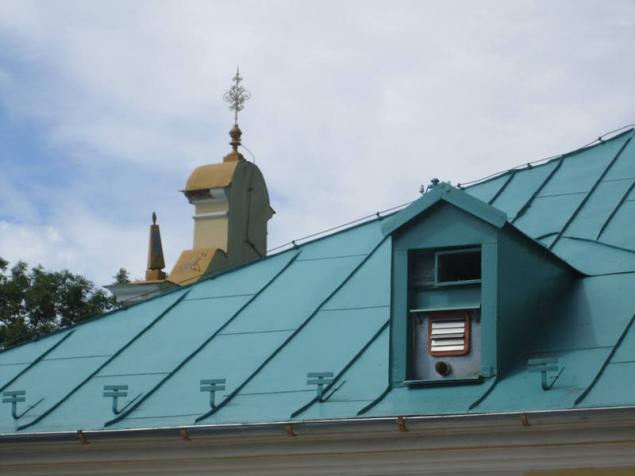
The device consists of three interrelated parts, namely:
lightning located in areas of intended contact with the lightning, that is on the object; the grounding conductor (current collector), collecting the charge from the lightning to the grounding (most often the metal wire of large cross-section); the earthing — rods and strips embedded in soil.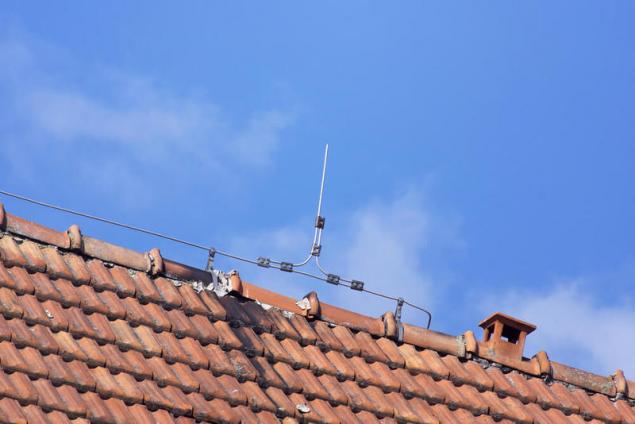
All parts of the lightning protection can be designed as a single freestanding design. For example, it may be a metal mast, which is both lightning, support, conduit and grounding.
The probability of a lightning strike in the end zone is very small. These zones are divided into two categories — A and B.
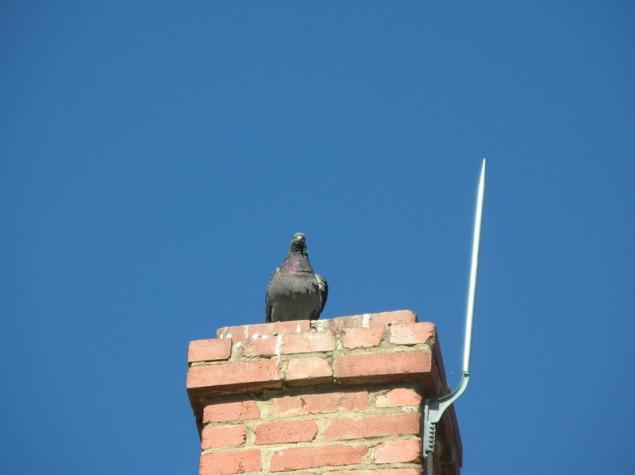
Lightning protection of a country house is conventionally divided into:
external, to neutralize a direct lightning strike to the house, internal — to reduce possible damage to the internal systems of the house. The system of internal lightning protection consists of devices of protection against pulse overvoltage caused by direct and indirect (for example, next to the house) lightning strike.
How to make a lightning rod? Thus, the lightning protection system consists of three parts: lightning in the form of a rod or wire or mesh current collector to send the discharge earthing and the earthing switch several metal conductors, in direct contact with the ground.
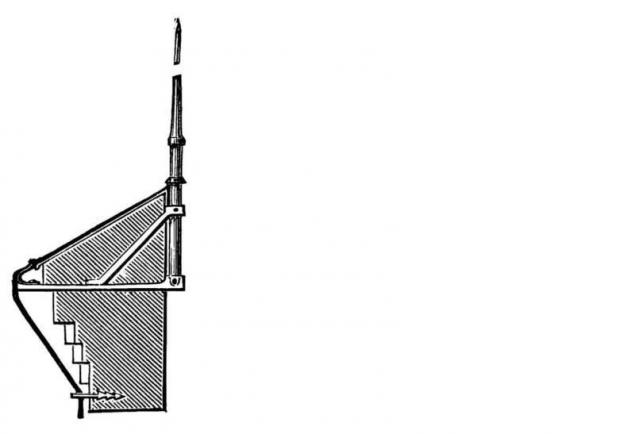
For rough calculation, you can use a simple rule: the radius of the protected area is equal to 1-1,5 height of the lightning rod. I.e. at the height of the lightning conductor 20 feet under his protection gets a circle with a radius of 20-30 m. If this square does not cover the area occupied by the house, establish two or more rods in different ways.
For the device of a simple rod lightning rod as lightning arrestors and use steel, aluminium or copper rod of the desired cross-section, without isolation and stripped of rust and paint. For example, steel wire rods diameter 8 mm. If it is a hollow tube facing up open end it needs to make.
When the lightning can not arrange, they can serve as the roof of the house if:
She beams and joints are metal. The thickness of the steel roofing sheet is not less than 4 mm. Under the roof is not combustible or flammable materials. The lightning can also serve as a TV antenna, chimney and raised the roof.
If the options considered for any reason does not fit, then alternatively you can place a lightning conductor on top of a nearby tall tree (the tree should be considerably higher than the roof of the house).
Cable lightning arrester satisfied along the ridge of the roof, pulling a metal cable between two supports. If the support is not wood, and metal, they are isolated from the cable reliable insulators. The ground connection can serve as metal corners, strip or sheet, embedded in the earth on depth not less than 0.7 m and at a distance from the walls of the house 1 m.
From walking paths to the earthing should also be removed not less than 5-6 m, and, if possible, placed in the shade. The condition on the distance is due to the fact that the storm may occur a step voltage with a potential for human fatalities. And in the shade in hot weather, the ground near the ground can dry out and bad conduct discharge. Therefore, earthing and have in the shade or in the place of frequent watering.
For the connection of structural elements of lightning protection are welding or threaded fasteners. The main thing is to have a solid connection, then a strong gust of wind or fall of a layer of snow will not be able to break it.
If your house is made of stone, the bus shunts can be "empty" directly on the wall. But if the house is wooden? In this case, the current collector is performed at a distance of about 10 cm and mounted on the electrically insulated mounting brackets.
When the lightning protection device even a small one-storey country house should be guided by:
Instructions for the installation of lightning protection of buildings and facilities RD 34.21.122-87 and the regulations for lightning protection of buildings, constructions and industrial communications WITH 153-34.21.122-2003. These documents will tell you all the nuances of lightning and provide the house with a reliable "roof".
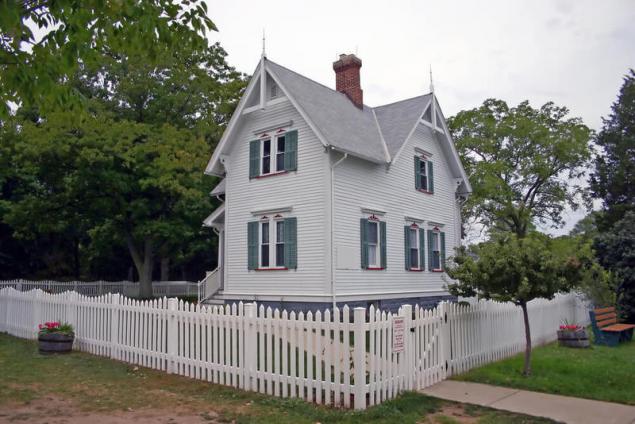
However, the lightning protection system of a country house for all its simplicity, has subtleties that must be considered in its design and operation. For example:
Today, with the commissioning of a lightning protection is not required, therefore, every homeowner makes a decision about expediency of its installation. Let's not wait "until the thunder clap". Moreover, he heard only a few seconds after the next "fire arrow" from digging into the ground. published
P. S. And remember, only by changing their consumption — together we change the world! ©
Source: www.7dach.ru/Oleg_Sanko/molniezaschita-dlya-zagorodnogo-doma-chto-zachem-i-kak-69861.html

After all, this is a giant electrical discharge of incredible power, whose voltage can reach several million Volts.
Whether at the cottage the lightning rod?A lightning strike to a building can lead to:
- fire and destruction of buildings,
- a short circuit in the wiring
- the breakdown of household appliances
- injury and even death of people in the house or near it.

That's why every self-respecting vacationer should take care of the security of their property and their families. But forewarned is forearmed.
The history of lightning protectionHistory erases from the memory the information about the origin of things, have become for us everyday, and not always reliably possible to know of the pioneer, without which we already can not imagine my life. According to official figures, the lightning rod was invented in 1752, the American Benjamin Franklin, whose stern portrait from 1928 looks at us with hundred dollar bills (or rather, those of us who have them). But with the withdrawal of the lightning worked well before Franklin. The mariners of Ancient Greece, for example, set the sword at the top of the mast, was tied to a wet rope and lowered the end of the rope into the water. Subsequently, it was replaced with a metal chain.
Risky experiment has Long been known that lightning usually fall within the objects rising above the earth's surface — trees, poles, masts.

And experiments with atmospheric electricity was carried out in many countries by different scientists. Franklin astutely pointed out that if the source category (electric car) connect a metal rod with the earth, the discharge from the machine, without sparks, and cod runs into the ground. And if the lightning was the same electric spark, why with his sharpened metal pole to discharge the cloud and not take dangerous charges in the ground? The research of Franklin consisted of the following: lightning falls into a special lightning rod which is installed higher than the level of the protected structure, then through the electrodes of the charge goes to the ground, and from there goes into the ground
Franklin decided to catch the lightning a kite at the end of which he tied a sharp nail. When the storm began, he launched the kite. In fact, lightning struck, and the wet rope held the electrical charge on its own from the top end to the bottom. By some incredible Fluke, the experimenter was not injured. From this experience he concluded that occurs during a thunderstorm the electric charges can be caught and taken to a safe place. So there was a device that in the Russian language for some reason called a lightning rod, though "assigns" it did not thunder, and lightning.
Options lightning protection Lightning rod is a metal pole, which is placed above a building and connected by wire with the ground. And the whole giant electrical discharge of lightning, causing harm to no one, goes into the ground.

According to the principle of lightning protection can be active or passive.
Active lightning protectionActive lightning protection, introduced in the mid 1980-ies, is the lightning, which does not take developing on top of a cloud discharge (streamer), but on the contrary, ionizes the air (which facilitates the passage of lightning) and creates a rapid discharge side of the zipper (the return streamer). If lightning will occur over the protected area, it is sure to be caught by lightning, and its discharge is taken to earth through the earthing system.
Devices may be specialized electronic circuits and switches, designed to trigger upon reaching a certain electric field intensity, and even small amounts of radioactive materials. Active protection system is much more expensive and complicated passive.

Advocates of active lightning protection claim that their lightning response generate early streamers of greater length compared to passive. This allows you to use less lines, and you can arrange them below. But despite such statements, the unconditional recognition of specialists active lightning rods are not found.
Passive lightning protectionthe Principle of operation of devices of passive lightning protection is quite simple and is based on the property of lightning to hit the high and grounded structures with good electrical conductivity. He is to intercept lightning, bound to the object and securing it in the ground, where it will not be able to hurt anyone, and in mitigating its impact for internal communications in the home.
Passive lightning may have a rod or cable design. Rod the lightning rod, towering above the protected object, — a classic lightning protection. In this case, lightning is caught in a protected area at the time of discharge.
Due to the elevation of the protected object and the special material from which it is made, the lightning rod takes the hit and passes it on through the collector to ground.
Another option passive lightning protection — cable system when the "interceptor" is stretched a metal cable. Cable lightning rods are used only to protect the narrow and long buildings (e.g. barns) or in case if it is not possible to install a sufficient number of rod lightning rods.
To cable the system applies marnieriana mesh. She laid on the roof with a certain pitch. All these systems are made of durable material high the conductivity — steel, copper, aluminium, which intercepts the discharge under the General laws of physics without generating additional action.
Lightning protection for a country house, What is the lightning protection of a country house? It is a device to prevent a direct lightning strike. A protector is a lightning rod for lightning and discharge it into the ground.

The device consists of three interrelated parts, namely:
lightning located in areas of intended contact with the lightning, that is on the object; the grounding conductor (current collector), collecting the charge from the lightning to the grounding (most often the metal wire of large cross-section); the earthing — rods and strips embedded in soil.

All parts of the lightning protection can be designed as a single freestanding design. For example, it may be a metal mast, which is both lightning, support, conduit and grounding.
The probability of a lightning strike in the end zone is very small. These zones are divided into two categories — A and B.
- In the area of category A, located closer to the lightning protection system, the probability of protection is of 99.5%.
- In the area of category B reliability a little less — 95%.

Lightning protection of a country house is conventionally divided into:
external, to neutralize a direct lightning strike to the house, internal — to reduce possible damage to the internal systems of the house. The system of internal lightning protection consists of devices of protection against pulse overvoltage caused by direct and indirect (for example, next to the house) lightning strike.
How to make a lightning rod? Thus, the lightning protection system consists of three parts: lightning in the form of a rod or wire or mesh current collector to send the discharge earthing and the earthing switch several metal conductors, in direct contact with the ground.

For rough calculation, you can use a simple rule: the radius of the protected area is equal to 1-1,5 height of the lightning rod. I.e. at the height of the lightning conductor 20 feet under his protection gets a circle with a radius of 20-30 m. If this square does not cover the area occupied by the house, establish two or more rods in different ways.
For the device of a simple rod lightning rod as lightning arrestors and use steel, aluminium or copper rod of the desired cross-section, without isolation and stripped of rust and paint. For example, steel wire rods diameter 8 mm. If it is a hollow tube facing up open end it needs to make.
When the lightning can not arrange, they can serve as the roof of the house if:
She beams and joints are metal. The thickness of the steel roofing sheet is not less than 4 mm. Under the roof is not combustible or flammable materials. The lightning can also serve as a TV antenna, chimney and raised the roof.
If the options considered for any reason does not fit, then alternatively you can place a lightning conductor on top of a nearby tall tree (the tree should be considerably higher than the roof of the house).
Cable lightning arrester satisfied along the ridge of the roof, pulling a metal cable between two supports. If the support is not wood, and metal, they are isolated from the cable reliable insulators. The ground connection can serve as metal corners, strip or sheet, embedded in the earth on depth not less than 0.7 m and at a distance from the walls of the house 1 m.
From walking paths to the earthing should also be removed not less than 5-6 m, and, if possible, placed in the shade. The condition on the distance is due to the fact that the storm may occur a step voltage with a potential for human fatalities. And in the shade in hot weather, the ground near the ground can dry out and bad conduct discharge. Therefore, earthing and have in the shade or in the place of frequent watering.
For the connection of structural elements of lightning protection are welding or threaded fasteners. The main thing is to have a solid connection, then a strong gust of wind or fall of a layer of snow will not be able to break it.
If your house is made of stone, the bus shunts can be "empty" directly on the wall. But if the house is wooden? In this case, the current collector is performed at a distance of about 10 cm and mounted on the electrically insulated mounting brackets.
When the lightning protection device even a small one-storey country house should be guided by:
Instructions for the installation of lightning protection of buildings and facilities RD 34.21.122-87 and the regulations for lightning protection of buildings, constructions and industrial communications WITH 153-34.21.122-2003. These documents will tell you all the nuances of lightning and provide the house with a reliable "roof".

However, the lightning protection system of a country house for all its simplicity, has subtleties that must be considered in its design and operation. For example:
- Metal roofing lightning protection possible with the use of the rod, and a polymer mesh.
- For a slate or wooden roof better to use a cable lightning.
- inspect all the parts of the lightning protection system,
- inspect the connections and fastenings,
- change the damaged places
- to clean contacts, etc.
Today, with the commissioning of a lightning protection is not required, therefore, every homeowner makes a decision about expediency of its installation. Let's not wait "until the thunder clap". Moreover, he heard only a few seconds after the next "fire arrow" from digging into the ground. published
P. S. And remember, only by changing their consumption — together we change the world! ©
Source: www.7dach.ru/Oleg_Sanko/molniezaschita-dlya-zagorodnogo-doma-chto-zachem-i-kak-69861.html
